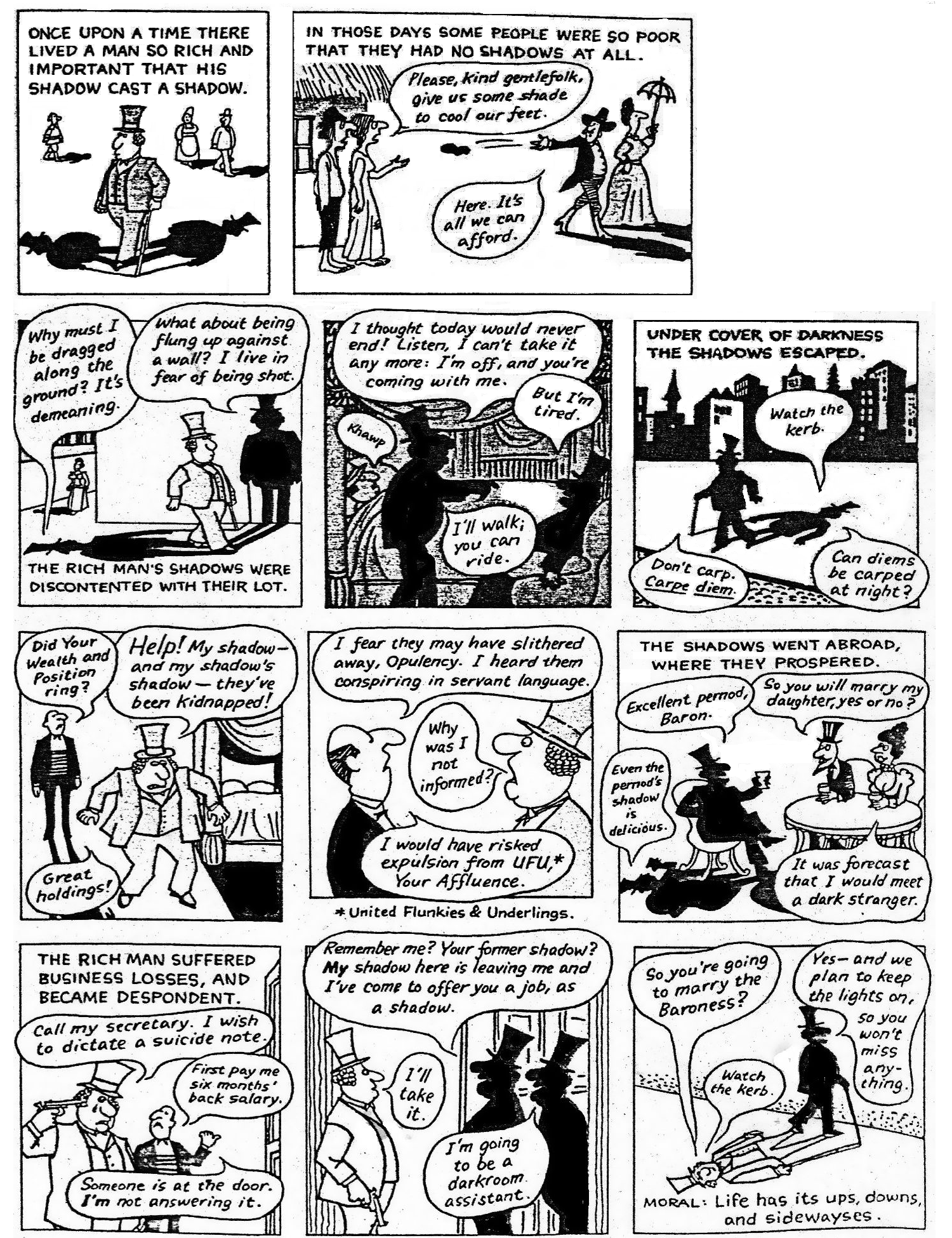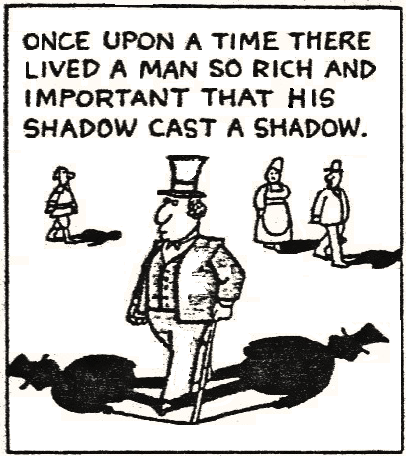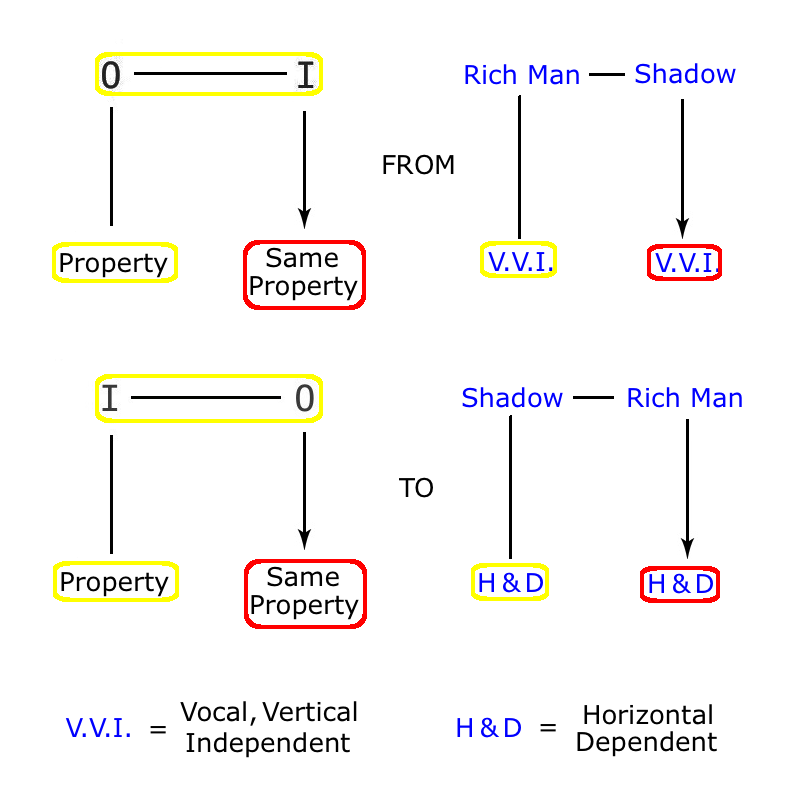A Rich Sequence of Twists on Shadows
In the cartoon strip below, we find eleven frames, all of them based on twists from, and around, the Original/Image relationship. It is a splendid ‘tour de force’ by Handelsman on the visual correspondence between shadows and their human owners. So here is the whole story, after which we can go through it all, frame by frame.

Before looking at the first frame in detail, it is worth observing how very well shadows lend themselves to this kind of story. Indeed, to create the same sort of narrative with reflections would be quite a challenge, given the troublesome and generally discontinuous nature of the reflective surface. This comes down to the physical ecology of reflections, which have a highly restricted range of environments (basically, water and mirrors), so unless our story was able to pursue its course, keeping to the side of a canal, and then passing through a hall of mirrors, and past a street with many windows, it would presumably falter, and die (and already the idea of such a narrative sounds somewhat contrived). Shadows on the other hand are free to move around from one place to another, irrespective of the surface encountered, and often very usefully on vertical surfaces, where they stand up like real figures. So they fulfil the need for the continous series of episodes that one finds in a story. Which is why, in the cartoon literature, it seems that shadows lead the more interesting lives, despite their almost complete lack of ‘filled-in’ detail.
FRAME ONE
Here then is the first frame. And straightaway, we find both a twist and a legit for our entertainment. A picture in which we find that the rich man has two shadows.

The logic is clear: the shadow has its own shadow – just like its owner. In other words, the image is behaving like its casting object in what looks like an imitation twist, where the image has changed by taking on an extra property. And what is particularly interesting about this property is that it is actually the shadow of the original. So the shadow behaves like its original, to the extent that it has its own shadow. Makes sense does it not? In fact, it makes so much sense that we forget just how impossible such an idea really is. Because shadows do not, and cannot, cast a shadow – light is the one and only source of new shadows.

We are told in the caption that the shadow casts a shadow. In imitation of the man in this case, along the same lines as even the rich mans servant has a servant. So this looks like a sidestep of the sort that we find in the image replacement twist, or even the copy sidestep. But visual correspondence is not obviously what the twist is about here, and in any case, the first shadow is still present and critical to the joke, which makes this imitation quite unlike the shadow of the jet cartoon. But it does look similar to the copy example, where the both statues are present (and further in to the shadow story, we find the same situation, with the rich man absent altogether). All of which makes this shadow of a shadow example rather an interesting one. Because sidesteps in the world of images are normally the rule, not the exception. Meaning that new shadows arise by sidestep everywhere, so that if an object has a material neighbour, then that neighbour will just as easily cast a shadow as the original makes one. Except in this one case, where the neighbour of the rich man turns out to be itself a shadow. Because that is the one kind of neighbour that does not normally cast a shadow. So this is the one place where a new image can be created, at least in our imagination, by making a sidestep from the original to a neighbouring ‘object’.

So we are not looking at a replacement twist, and we are looking at a rather unique example of an imitation twist, where the image takes on, not a property of its original, but a neighbour of its original. To be clear about this, let us compare two image imitation twists to the jet shadow cartoon. The first frame is the one we are looking at. The second is another imitation twist, this time where the shadow copies a property of its original, namely speech. And the third is our example of an image replacement, where the normal shadow is replaced by the shadow of the neighbour of the original.

The red lines are helpful because they show the link between the visible elements actually presented in the cartoons. What they show is the pattern common to image imitation twists, and the rather different situation with the image replacement twist. In the latter there is a major break in visual correspondence, with the complete removal of the normal shadow. In the former, there is no obligatory break in VC at all. For example, a shadow may speak with a speech bubble without moving its lips (and it would have to be presented in side view to show this in any case, because shadows are black and do not give much away about themselves). Which means that the original shadow remains in position. However, in the case of the shadow casts its own shadow, we find that two shadows are present, rather like we see in the copy imitation twist, where two statues are present. But whereas there are many possible copy sidesteps of this sort, there is only one image sidestep of this sort for the reasons outlined above (the world of images does the sidestep as a matter of course, so there are no new images).
The legit that is drawn alongside the original diagram of ‘the shadow has a shadow’ twist, is also of some interest. Because although the twist is one that amounts to a disruption of the patterns of Physical Space (shadows never have shadows), the legit is drawn from deep inside Social Space (‘there lived a man so rich and important’). This is because matters of poverty, wealth and general status are major social issues, and here they are used as the basis for a justification of the entire twist. Rich people have many more possessions, and shadows are merely possessions to have more of. This is therefore a very easy legit to understand, and accept. In any case, it seems to make sense that a shadow could cast its own shadow, but why is that?
Well, the logic of the imitation twist is based on the familiar ‘A is to B as C is to D’ format, where the relationship sets up the two sides, and the twist sets up the two lines of logic, one good and one, well, twisted.

So what this diagram emphasizes is how the twist justifies itself by making a parallel between the actual reality on the left, and that other imaginative world of the possible reality on the right. The wealthy man legit does in any case tie the whole twist up nicely of course, but the fact is, we want to accept the move to the right on its own merits anyway. After all, why shouldn’t a shadow cast a shadow? Additionally, in the back of our minds, we know that an object can cast two different shadows if there are two different light sources. So it really does seem half plausible, until we think about it more carefully, and by that time we are already reading the next frame so the whole question gets lost in the slipstream anyway, all caused by our impatience to read on, and find further entertainment.
FRAME TWO
As indeed can we, by looking at the next frame. Where we find that the poor people are so poor that they don’t even own a shadow. But why would they want a shadow, and why would they be grateful to get even just a small piece of one? Well, because it keeps their feet cool…

We can see several twists in this second frame. Firstly, the poor couple have no shadows. It is important that the cartoonist makes this abnormal lack of shadow clear, because it could be due to an absence of sunlight or even just an omission in the graphic art of the cartoon. Which is why the caption spells it out (‘they had no shadows at all), and why the other couple are shown casting perfectly good shadows. The second twist presents us with the rich couple, who are throwing a ‘piece of shadow’ to the poor couple. That is, the image is being made to behave as if it was a real item of material substance from the physical material. Thirdly, there is the idea that this piece of shadow can offer human feet some shade. Which not only justifies the donation of a part of a shadow to the poor, but also acts as a twist that deliberately confuses the condition of ‘being in the shade’ with the situation of ‘casting a shadow’.
So the absence of a shadow is a classic example of the ‘Image Removed’ twist, where the couple have no shadows, just as they have no shoes – because they are poor.
The second twist shows the shadow imitating the material world by taking on precisely that general property. So it is shown as a material, and in this case, a piece of material that can be proffered to the poor. Which therefore looks to be an example of an ‘Image like Original’ imitation twist, because the image is taking on the property of materiality. That is, a property of the original is being transferred to the image, and in so doing, it also breaks the visual correspondence between the two, because the piece of shadow is shown on its own, without its casting object. In fact, strictly speaking, this is a removal of the original, with the image remaining, but as the shadow is being treated as part of the rich couples overall shadow, we should probably argue that the property imitation twist is a good enough explanation in this particular case. Put another way, the removal twist is simply the inevitable consequence of the imitation twist, but it is the latter that is important in this part of the narrative sequence.
So here is the logic schema for the second twist in frame two.

In visual terms, it is easy for the cartoonist to support the notion that the piece of shadow is like a piece of material: it is opaque, and therefore looks a lot more substantial than it really is. So this visual illusion, caused by the way in which the 2D medium of the drawing takes away the normal asymmetry between the 3D object and the 2D shadow, and reduces them both to an apparently equivalent flatness, certainly seems to carry this twist on its own, without further qualification. But what about the idea that a ‘piece’ of shade can cool the feet, which is the reason that this charitable action is happening in the first place? Well, it may be a total fiction, but the neighbouring idea of being ‘in the shade’ makes it looks perfectly reasonable, just as long as we don’t think too closely about it. And the ‘need for shade’ gives the poor people a good reason to beg for it, which is vital if this imitation twist is to see the light of day.
FRAME THREE
In frame three, the two shadows start complaining about their position in life – literally. Because it seems that being flung against walls and being dragged along the ground is apparently (and in this case ironically) no joke. Now this is an example of a dissatisfaction that we have seen before, albeit in a different guise, in the context of the ‘Bears in the Children’s Zoo’ cartoon, where the bears are also busy grumbling about their lot. Because, and this is worth repeating, there is perhaps no more human behaviour than that of the act of complaining. Meaning that the shadows are imitating their generic masters in a way we fully recognise as completely human. All of which is yet another step in the continual play between humans and their animate shadows that is the principal feature of this story. But this imitation twist is also important as the preparation for another removal twist in the next two frames. Because it is precisely the discontent of the two shadows that justifies their taking off on their own, leaving their master bereft of them both.

So this is an image change twist, where the image imitates its original, or at least exhibits behaviour characteristic of humans in general. Nor can we see any obvious break in visual correspondence here. Which means that it is a ‘pure form’ of the imitation twist, unlike the more common form of this twist, where the image is pulled into a break in VC as well. Time for the next frame.
FRAME FOUR
In frame four, we continue the theme that the shadows are fed up with their lot, and now they decide to take off on a new life together.

Has their dormant owner put the lights out before going to sleep? Well, if he has, then that is not enough to put the shadows to sleep it seems, for they are happily transgressing the laws of physics by not only remaining there, in the room, but doing so in a condition that suggests the presence of full sunlight. However, this is a pernickety and pedantic point – because most of us would ignore such considerations in favour of following the story. A story in which we see stage two of the ‘pre-flight alignment’ for the separation of the master and his shadows. And we are told that the lead shadow is going to walk, so that the other, ‘tired’ shadow can rest. Which makes for a nicely whimsical application of the idea that in normal life, the shadow gets a free ride off the casting object. An idea that is enabled, in terms of the sequence of ideas, by the fact that one of the shadows is tired. Anyway, plenty more of the image imitation twist going on here.
FRAME FIVE
Time for a dreadful pun it seems. A play on the Latin expression, made so well known in the film ‘Dead Poet’s Society’, that is used here ironically, given that they are not literally seizing the day, but the night time. There is a play between the Latin ‘carpe’ (seize) and the similar sounding word in English (complain), not with any particular sense in mind, but just for the sake of it. This is followed by an effort to turn ‘diem’ into an English word too, as if it might be some kind of a noun, and again this is not a piece of well crafted word play. But it is good enough as the fill in that takes us to the next scene.

Their flight is achieved ‘Under Cover Of Darkness’ according to this next frame, which would makes sense for a pair of human fugitives, but not for a pair of shadows, because they would disappear altogether… But perhaps that is the point. In any case, for the sake of visual clarity, we are perfectly happy to accept such a departure from our normal experience, in order to follow the story as it progresses.
So, after the shaky wordplay, the shadows make off, presenting us with a continuation of the images behaving like their original human figure. To wit, we even find that one of the shadows has taken command, and assumed the place of the human original, and that the other has adopted the position of the shadow on the ground. So although the idea of two shadows acting like this may be an affront to our knowledge of the physical world, we keep the niceties going here, because actually it looks right, even though we know it is not.
If a shadow takes the place of its original, then we are looking at an ‘Original Removed’ twist. And the fact that it has a shadow of its own greatly assists this illusion because, as we have just mentioned above, the set-up still looks authentic, given that we are looking at a pair of figures that resemble the normal arrangement of original and image. So, what is notable about this replacement twist is that in this case, the original has been replaced not by a category, contextual or property neighbour, but by an O/I neighbour – its very own shadow. Which makes for a perfect legit, because the new arrangement more or less exactly matches the classic dualism of the master and his shadow.

FRAME SIX
In the next frame, we get the point of view from the original. There is nothing of image interest for us here, because as far as the O/I relationship is concerned, we are just continuing with the image removed twist (although in this case, two images are now missing). Though we are set straight about the relationship between the two shadows: ‘my shadow – and my shadow’s shadow’ just in case there was any doubt. Notice that the rich man’s flunky (and the bed) have a proper shadow to underline the absence of the other two shadows.

FRAME SEVEN
However, in the next frame, the shadows are taking their imitation of the human condition further still, not only prospering, but even contemplating marriage with a real human woman. Notice how the imitation twist is pursued even further, with ‘the pernod’s shadow is delicious’. And there is a bit more wordplay in the allusion to the ‘dark stranger’ too.

FRAME EIGHT
However, in the next frame, the shadows are taking their imitation of the human condition further still, not only prospering, but even contemplating marriage with a real human woman. Notice how the imitation twist is pursued even further, with ‘the pernod’s shadow is delicious’. And a bit more wordplay in the allusion to the ‘dark stranger’ is added for good measure.

In addition, the pair of images continue to behave like an Original and Image pairing. This makes it easier for the cartoonist to set up the meeting with the baron and his daughter, acting as they do in an equal position. Because now, the usual problem that normally dogs image twist presentation, which is the contrivance of suitable surfaces to carry, in this case, the shadows, is no longer an obstacle with the shadows free floating as they are. Meaning that there is a good degree of artistic latitude to be had in the presentation of the image twist once the dependence between it and its original is severed. And talking of latitude, we see that shadow on the floor only vaguely corresponds to the casting shadow on the chair. But no matter. Visual clarity and narrative is all. So the story then continues below, with the setting reverting to the hapless original, who is now being prepared for the final twist.
FRAME NINE

The threatened suicide by the original prepares the ground for his then doing a complete turn about, and embracing the otherwise unappealing result of the twist to come in the final frame, where he takes up the offer of becoming a de facto shadow himself.
FRAME TEN

Here we find yet another legit drawn from deep inside Social Space, this time to do with the issue of employment. The Original plans to take the job, and behave as a shadow (yes, as the shadow of his own shadow). Meanwhile, the second shadow is going off on his own. So in the final frame, we reach the ultimate conclusion of all this shadow play:
FRAME ELEVEN

The final conclusion to the story is that the two principal protagonists have now exchanged places, with the shadow behaving like a human and the human taking over the postion of his shadow. This is the final consummation of all that has gone before, where the total separation of the two participants can now be seen as a way of getting them to recombine with their positions reversed. So, putting the initial twist of the ‘Image like its Original’ together with this final twist of the ‘Original like Image’, we get the following schema.

What we see in this end frame picture is a decisive and final denouement. Not only does the shadow behave like its original, but the balance is complete because the original has now taken the place of its shadow.
One last comment about this shadow story then. Many of the twists on images that we see in the cartoon literature are based on the human figure. This is because humans and their activities are at the centre of Social Space, and for cartoons, that makes them the visual anchor point for all the possible dimensions of meaning that we find interesting. In contrast, image twists that deal purely with Physical Space are generally of less interest, although they can always be pulled back into Social Space by a legit, gaining further meaning in doing so. But for example, the multi-frame cartoon by Mordillo that we considered earlier, where the the tree is cut down and the shadow remains on the wall, is a twist targeted solely on the logic of Physical Space. And its justification is based entirely on the visual authority of the graphics, with no trace of a further legit evident. All of which makes the Mordillo cartoon quite banal in terms of meaning, albeit pleasingly simple. A simplicity in marked contrast to the Shadow Story it must be said.
In that contrast, we see that the cartoon story of the shadows is neither banal nor simple. This is because the story pushes its shadow participants deep into Social Space, where the possibility for their enrichment in meaning is, by definition, far greater. This is just as much thanks to the nature of the legits as it is to the twists. Because the legits draw heavily on ideas from the core of human meaning, to do with such issues as the relative poverty and wealth of its protagonists, the degree of comfort and quality of their lives, and their need for gainful employment. And all of these issues are as near to our hearts and minds as they are as far removed from the physics of light casting images on certain surfaces as it is possible to imagine.
And the last word? Well, the last word goes to the story end, where the moral chosen by the cartoonist nicely defines both the human condition, and the nature of humour.

